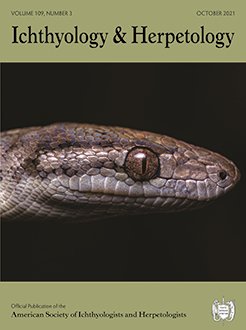Redspot Chub (Nocomis asper) are a keystone species in Ozark Highland streams of the Arkansas River drainage because their unique mound-building reproductive behavior facilitates recruitment of nest associates. Data contributing to an increased understanding of Redspot Chub natural history is required for the conservation of this species as it is listed as a species of concern throughout most its range. The findings presented within thoroughly describe Redspot Chub feeding ecology by documenting an ontogenetic diet shift, patterns of seasonal resource use, important prey taxa, estimates of trophic position and dietary niche breadth, as well as documenting feeding strategies at population and individual levels. Diet collections were conducted seasonally in 2018 and 2019 at four sites on Spavinaw Creek in Arkansas and Oklahoma. Logistic regression provided evidence for a previously undescribed ontogenetic diet shift, which split Redspot Chub into two functionally different species from a dietary perspective. Redspot Chub ≥ 162 mm total length (TL, RSCB) occupied a significantly higher trophic level than Redspot Chub < 162 mm TL (RSCS). In terms of caloric contribution, Ringed Crayfish (Faxonius neglectus neglectus) nearly accounted for the entire diet of RSCB, regardless of season. This specialization led to a much lower overall dietary niche breadth when compared to RSCS. Furthermore, Amundsen plots clearly depicted RSCB population specialization on crayfish. Conversely, Trichoptera were the most important prey across seasons for RSCS. Coleoptera, Ringed Crayfish, and Ephemeroptera ranked second in importance at different times seasonally. RSCS also possessed a relatively narrow niche width, but Amundsen plots exhibited a pattern where seasonally the two most important prey types were specialized on by approximately half the population, while smaller proportions of the population specialized on less commonly used prey resources. Species' diets reflect an integration of numerous ecological components; therefore, our aim was to provide a greater understanding of Redspot Chub feeding ecology that may be useful for informing future conservation assessments and management decisions.
How to translate text using browser tools
17 September 2021
Ontogenetic Diet Shift, Feeding Ecology, and Trophic Niches of the Redspot Chub (Cypriniformes: Cyprinidae: Nocomis asper)
Anthony W. Rodger,
Trevor A. Starks
ACCESS THE FULL ARTICLE

Ichthyology & Herpetology
Vol. 109 • No. 3
October 2021
Vol. 109 • No. 3
October 2021




